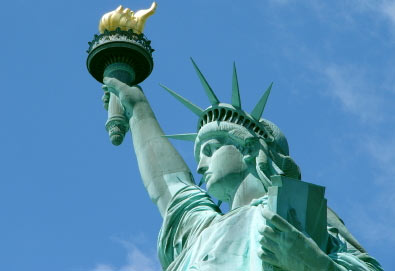Chasing the American dream

The American Dream continues to fascinate most of us here. Every year, thousands of Nepalis apply to the Diversity Visa programme, which assures the winners of this lottery the right to live and work in the US. Increasing number of students apply to American universities every year. Nepal is now 11th in the rank of countries that sends students to the US, with 11,233 students being accepted in 2009-10.
But the American Dream is not realised just by landing in the US or getting a Green Card. There are multiple tales of Nepalis working in low-paying jobs (by US standards), of employers promising Nepalis a permanent visa and never living up to the promise, and of other Nepalis overstaying their tourist visas and becoming illegal, or “losing their status”, to use the American expression. A coherent picture of Nepalis in the US has been difficult to realise, especially in a country where numbers and figures can be found for almost everything. A New York-based organisation, Adhikaar, has taken a step ahead to correct that with its survey of Nepalis living in New York—a first of its kind.
The picture that emerges from the survey, which spoke to 300 Nepalis across a broad economic spectrum, is that most decided to immigrate to the US in the last decade, with 85 percent moving in the last nine years alone. The first reason for this trend obviously seems to be the conflict. “It is fair to say that the conflict did play a major role,” says Luna Ranjit, co-author of the study and executive director of Adhikaar. “People might have been directly affected by the war and fled to avoid persecution.” She believes other factors, such as a stagnant economy, political uncertainty, and regular closure of schools and colleges have contributed to the Nepali exodus. “The Diversity Visa programme also played an important role in the migration.” Nepal is now third in Asia among countries which send immigrants to the US on the DV programme after Bangladesh and Iran, with 2,132 winning the lottery last year.
A natural consequence of the overwhelming number of people migrating in the last decade means that most Nepalis in New York are first-generation immigrants, who face “the challenges faced by other recent immigrants.” This means that most have to start from scratch, unless they have an educational degree from a US university. The other factor that affects their current economic status is the fact that nearly 70 percent of the respondents had only studied till grade 12, which limits their chances of getting a non-menial job. Most Nepalis in New York earn less than the average worker in the US—nearly 70 percent of Nepalis earn less than $30,000 per annum vs. the average US income of $ 42,336 per year. Says a respondent: “There is a big difference between what you think about America in Nepal and when you actually come here (sic)…We have to work 70-80 hours a week and that is really hard.” The average American works 46 hours a week.
The hardships are evident. The survey quotes an example of three individuals who had a Nepali undergraduate degree and had worked as professionals in Nepal, “yet only one of these individuals was able to find a job in the United States,” comparable with her position in Nepal. The biggest challenge in finding a suitable job, according to the respondents, is their lack of English skills (42 percent). But a high percentage of respondents (41 percent) also don’t know how to look for jobs. “Since Nepalis are relatively new to the country, they have not been able to grow their roots here yet,” says Susan Hangen, co-author of the report. As they can’t find regular jobs, most Nepalis work in the informal sector, often experiencing long periods of unemployment. Most work for hourly wages in restaurants, grocery stores, fuel stations, and in the case of women, as domestic helps.
And don’t get misled by the fact that a majority of Nepalis (55 percent) still send money back home. “There is definitely a growing remittance economy (functioning) out of New York City,” says Ranjit. Prabhu Money Transfer, a Nepal-based remittance company, operates three branches in the New York neighbourhood of Jackson Heights alone.
Jackson Heights is highly relevant. An immigrant hub, the neighbourhood has a high concentration of working-class Nepalis. More than half of its residents are immigrants, with South Asians making up nearly a fifth of its population. Ask anyone who has returned from New York, and they will regale you with tales of how the neighbourhood smells of samosas and chaat while Lata Mangeshkar songs blare from its stores. A New York returnee recounts how he would take visiting Nepalis to Jackson Heights, where they would buy chiffon saris and gold jewellery “desi style”.
Yet, this growing presence of Nepalis in New York still suffers because of a relative lack of integration with other immigrant communities in the mega-city. “Most immigrant groups are pretty self-sustaining and have few contacts with other groups socially, politically, or culturally,” says Hangen, as a result of which, there is no cohesive unit among these groups. Nepalis in New York speak of a desire to remain close to one’s native community as the prime reason why they do not integrate in the larger New York community. “I spend so much time with Nepalis in New York that at times I ask myself whether I am in the US or in Nepal, and whether it’s the right thing to do,” says a 37-year-old Nepali who works as a waiter in New York.
In the light of the recent economic recession and a downturn in the American economy, immigrants as a whole are being accused of taking jobs away. “There is a growing anti-immigrant sentiment, and anti-immigration laws are being implemented all across the country,” says Ranjit. This sentiment is sometimes reflected during job searches as well. Ranjit says there is anecdotal evidence of discrimination, but as discriminating on the basis of nationality is illegal, it is not “very obvious”. More striking is the fact that reports of discrimination arise from those employed by South Asian, particularly, Indian immigrants. “They carry the mindsets from back home and view Nepalis as inferior,” says Hangen.
But more than discrimination, the bigger problem is the false promises made by employers to guarantee Nepali immigrants Green Cards. “Employers promise to apply for their Green Cards and exploit the workers, making them working extremely long hours and paying them little or nothing,” Hangen says. Ranjit agrees, “In most cases, the promises are fraudulent. Workers are made to overstay their visas, and are left with no options.”
Yet, the American Dream lives on in the minds of those back home in Nepal. Ranjit says because fewer stories of difficulties emerge from the US, “people do not realise the extent of problems faced by immigrants here.” And as far as realising the American Dream goes, it has come true for those “with higher educational degrees—often from a US institution, and good English skills.” But for the majority of Nepalis, “the American Dream is nothing but a myth.”
source: Mulmi, Ajay (2010),"Chasing the American dream", The Kathmandu Post, 12 Dec 2010
Posted on: 2010-12-12































